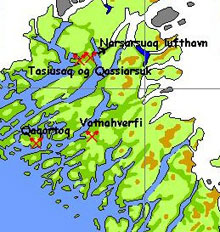The Greenlandic Arboretum in Narsarsuaq
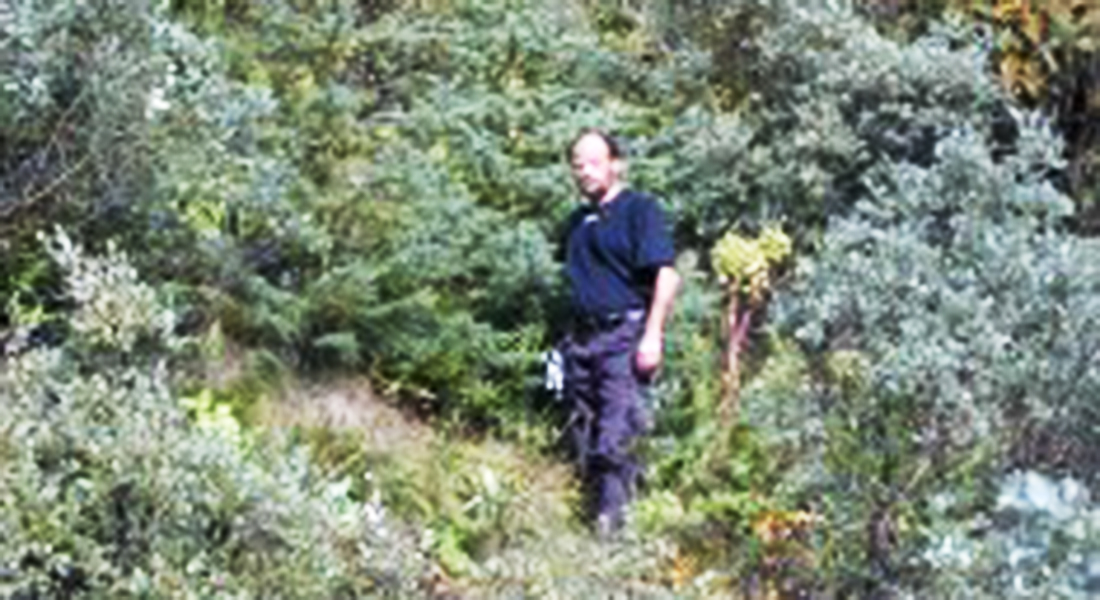
|
|
The Greenland Arboretum is an idea that began at the end of the 1980's after the trial plantations in Narsarsuaq became more and more comprehensive. This was the result of the systematic plantings of Dr. Agro. Søren Ødum (1937-1999), which began in 1976. Søren Ødum planted a number of species and provenances in May 1976, but because of a drought in the following summer many of the plants died that year. Today only 21 trees remain from this planting. They represent 7 species and 14 provenances, primarily from the Rocky Mountains in the USA. The source of this material was the collecting expedition of the Hørsholm (Denmark) Arboretum to the USA in 1971. In 1978 and 1979 Søren Ødum worked further north, in Sødre Strømfjord/Kamgerlussuaq. First in 1982 he resumed his activity in Narsarsuaq together with Poul Bjerge. They restarted with Alaska material, among which was the well-adapted white spruce from Broad Pass in the Alaska Range. Today, after 20 years, these trees are up to 3.5 m tall. In 1982 Søren Ødum participated in a collecting expedition to Northwest North America which resulted in very exciting material for the Greenland trials. In 1983 Søren and Poul continued the plantings, where the Alaska collection was expanded and material from the collection in 1971 was replanted. The collecting expedition in NW North America was repeated in 1985, and resulted in a very extensive collection from this area. In 1984 and in 1986, they continued with the plantings of this material. In addition, plant material from the northern Nordic countries, Sweden, Finland and Norway was introduced. In 1987 there was a larger planting of material. These were primarily, seedlings from seed collected in 1982, and 1985 but also from the collection in 1971. Moreover the collection of broadleaved trees (angiosperms) had developed well with the planting of species of Betula, Alnus, Prunus, Sorbus, Populus and Salix as well as other. A large-scale establishment of shelterwood trees was started in 1988 with the planting of 20000 trees of three different taxa. These were the white spruce x Sitka spruce hybrid (Picea x lutzii) (10000 individuals), Norway spruce from Mor I Rana in Northern Norway (4000) and lodgepole pine from Stewart Crossing in Yukon (5000 individuals). The idea behind the background plants was to create a forest climate, where in the future one could plant species that require shelter. These shelterwood plantings continued in 1989, 1991, 1992, 1994, 1998, 2001, and will continue again in 2002. The planting in 1988 was carried out as a student project of Kenneth Høegh (agriculture student), Mads Nissen (forestry student) and Anders Jensen (forestry student). Agronomist Kenneth Høegh and forestry candidate Mads Nissen had continued the work with the development of the Arboretum up through the 1990's, in cooperation with Søren Ødum. Throughout the 1990's and into the year 2000 a much larger number of species and provenances have been introduced. They have come from collections in N.W. North America (1991), East and Central North America (1993), the Central Alps (1999) and in Siberia (2000) as well as other places. A number of volunteers have participated in the work on a philanthropic basis, as well as co-workers from the Arboretum in Hørsholm Denmark, the Iceland Forestry Service, students from the Agricultural University in Denmark, and agriculture students from the Upernaviarsuk research station, as well as other individuals. The first stock taking of the Arboretums plants came in 1992, when Mads Nissen completed a report on the Arboretum. This report as since been revised and broadened, and now occurs both as a database and a spreadsheet program. The goal of the Arboretum is to establish a collection of trees and bushes from both the alpine and the arctic tree-lines of the Northern Hemisphere. The collection will certainly be of recreational value in the future, as a botanical garden, as a local attraction and as a tourist attraction. The plants will also be an excellent climate indicator, as well as be a guide or reference for plant choice in the Southwest of Greenland. The establishment of the Arboretum is primarily financed by external sources. Funds which can be mentioned are: The Royal Greenland Fond, Danish Crown Prince Fund, Aage V. Jensens Fund, Folketingest Greenland Fund, NATOs Grants Committee, Bestle, and most recently the Nuna-Fund under the Greenland Bank. The Arboretum was officially opened in August 2004, when the Nordic Arboretum Committee had its yearly meeting in Narsarsuaq. The Arboretum is probably one of the most extensive tree-line arboreta in the world, comprising about 150 hectares, with about 110 species and about 600 provenances of trees and bushes. |
| A surprisingly lush vegetation is found in the inner south Greenland valleys. But it is vegetation that is species-poor. There are no conifers except for the creeping common juniper (Juniperus communis var. saxatilis). The reason for the lack of species richness is found in Greenland's isolated position which makes it difficult for plants with heavy seed to invade. This includes most of the conifers and species of the pea family. |
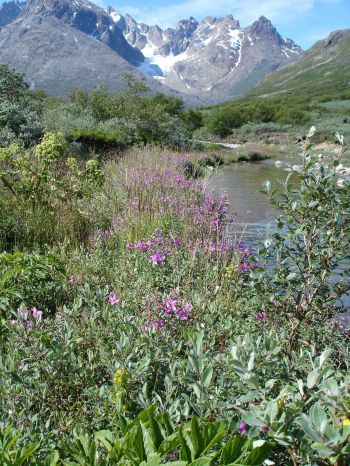 |
| Fig.1: Shrub consisting of Gray-leaf willow (Salix glauca) and fireweed (Chamaenerion latifolium), The Qingua valley. Photo: Jørgen Kjær Jensen, July 2006 |
|
However, a potential forest zone is indicated by the brushwoods of mountain birch (Betula pubescens ssp. czerepanovii, previously ssp. tortuosa) (Fig. 2) and the more scattered occurrence of the Greenland mountain-ash (Sorbus groenlandica) (Fig. 3) as well as American green alder (Alnus crispa). Mountain Birch are found in a number of localities. It is mainly found as single individuals in the coastal regions, while only found as a luxuriant forest (continuous with heights above 5 meters) in isolated localities – here in association with Greenland mountain ash. The Qinngua valley (Fig 1, 2) being the most well-known forest locality was protected by law in 1930 by the Danish Colonial Administration. In the summer of 2007 the first project of its kind was initiated in Southwest Greenland. The project surveys and compares the climate in the Tasermiut Fiord including the undisturbed Qinngua Valley with simultaneous data collected in the Tunulliarfik Fiord system. The latter being an area where human-caused disturbance has been significant since the Norse settlement just before A.D. 1000. The project will determine whether climate elsewhere in Southwest Greenland is the main factor limiting birch from developing into treelike structures, like those found in the Qinngua Valley. Future data obtained from the above mentioned areas will help to determine if human activity is causing the failure of birch re-establishment. In addition the data will help to identify potential areas for future protection or production. |
 |
| Fig.2: Forest of Mountain Birch in the Qinngua valley, Nanortalik District. Photo: Rasmus Christensen, July 2007 |
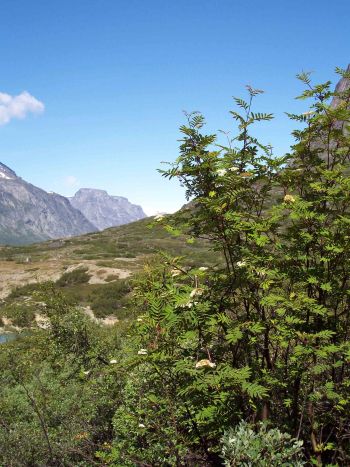 |
| Fig.3: Greenland mountain-ash (Sorbus groenlandica), “Klosterdalen” valley, The Tasermiut fiord. Photo: Rasmus Christensen, July 2007 |
|
The lack of warmth during the growing season (low heat-sum) is a strongly limiting factor for tree growth in Greenland. Before winter starts growth should be completed, and new shoot and buds should have been hardened. Violent, dry foehn (Chinook) winds from the inland ice cap occur during the whole year. During the winter, these foehn winds cause complex damages. If one is to develop a picture of where the forest limit occurs in Greenland, can one look at the vegetation in similar areas in North America. The nearest relative to the Greenland mountain-ash is the northeast American mountain ash (Sorbus decora). It occurs neither higher, nor further north that the forest limit which is created by the conifers. Thus it is probable that conifers can grow in the summer-warm, inner fjords in Southwest Greenland where one finds the Greenlandic mountain-ash. In the White Mountains of New Hampshire the tree-line forming balsam fir (Abies balsamea) and black spruce (Picea mariana) and on Labrador's northern limit for the mountain-ash one finds black spruce, white spruce (Picea glauca) and tamarack (Larix laricina). At this area 5000 self-sown seedlings were collected in 1993 for planting in Greenland. The oldest surviving introduced trees in Greenland are "Rosenvinges Trees", Scots pine (Pinus sylvestris) and Norway spruce (Picea abies) from northern Norway. These trees were sown near Narsarsuaq in 1892. Today there are four surviving Scots pine trees, which are 5 meters high and very strongly wind-shape (Fig. 4) |
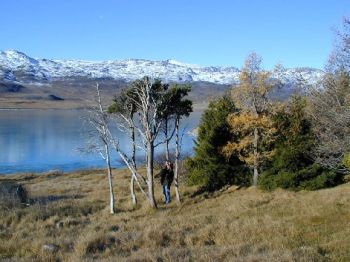 |
| Fig. 4. Rosenvinge's trees in Qanasiassat, 4 Scots pine (Pinus sylvestris), from north Norway on a 5 m hump, sown by the botanist Rosenvinge in 1892. Photo: Poul Erik Pedersen, August 2000 |
| The natural Greenland brushwoods and "Rosenvinges trees" inspired The Royal Agricultural and Veterinary University (C.A. Jørgensen and C. Syrach-Larsen) and the Forest research department (C.H. Bornebusch) to study the possibilities of planting forest in Greenland. Since 1953 the Upernaviarssuk Research station, the Arboretum of the Royal Veterinary and Agricultural University, and the State forest tree-breeding station as well as the Icelandic forest council have worked to procure suitable forest plants. In the first optimistic period and up to 1950's a wide variety of northern material was tried. With few exceptions all these trials failed in establishing trees with notable exceptions. Survivors included Siberian larch (Larix sibirica), Scots pine (Pinus sylvestris) and Norway spruce (Fig. 5) from northern Norway, white spruce and the white spruce-Sitka spruce hybrid called Lutz spruce (P. glauca x sitchensis or P. x lutzii ) from the southern Alaska as well as a few others. The especially cold summers of 1982-1984 filtered out the planted trees and provided the basis for a more narrow selection of species and proveniences for more extensive plantings. |
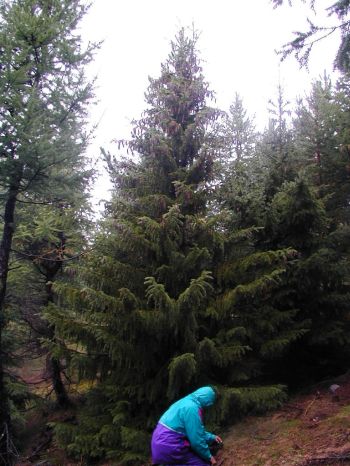 |
| Fig. 5: Norway spruce (Picea abies) from north Norway, Qanasiassat plantation, planted in 1953. Photo: Poul Erik Pedersen, August 2000 |
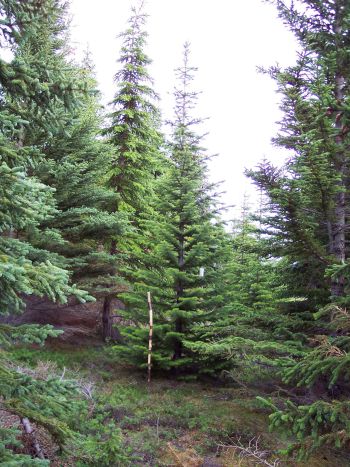 |
| Fig.6: Abies lasiocarpa from 1982 in The “Kuussuaq” forest, The Tasermiut fiord. Photo: Rasmus Christensen June 2007. |
|
The head of the Arboretum (Dr. Søren Ødum, 1937-1999) in cooperation with the forest officer Poul Bjerge (Upernaviarsuk research station), was the driving power for the Greenland planting trials up through the 1970's and through to the end of the 1990's. Søren Ødum made a colossal work to find the right plant material, and many species and provenances were introduced by Søren Ødum to the plantations and gardens of Greenland. Søren Ødum started trial plantations in the community of Nuuk (Qooqqut), Kangerlussuaq/Sødre Strømfjord and founding the Greenland Arboretum in Narsarsuaq. The most promising possibilities for finding the best adapted plant material for the Greenland climate has been shown to be collecting trips, where the material is purposefully collected near tree-lines. For a good result it is critical that the trees are adapted to a short growth season. They need to have a late timing of bud-break, an early stop of growth, and an early maturation of the shoot. By collecting material from a little more northerly latitudes than the planting area, one can often obtain a little earlier stop of growth and earlier shoot hardening. In this way the risk of freezing and scalding by the foehn winds after a cold summer is reduced. The price is that the annual height growth is somewhat reduced. Commercial seed from tree-line areas is not normally found on the market because the long time between good seed years when it is possible to harvest a large amount of seed of good quality. On the collecting expeditions seed is collected where and when it is possible, and in addition a large number of small plants are dug up for later planting. Thereby time is won with an earlier test of the provenances and material, which can also be established in more accessible seed plantations. Since 1981 the main effort has been to obtain material from directly from the forest tree-lines. Collecting expeditions have been made to the following areas: Alaska and Yukon (1988 Søren Ødum), Alaska, Yukon and North West Territories (1991, S. Ødum, Kenneth Høegh, Mads Nissen, Thomas Guldbeck), at Hudson Bay in the northern Manitoba and Northern Quebec/ Ungava Bay (1993, S. Ødum, K. Hoegh, M. Nissen, Poul Bjerge), the Euorpean Alps (1998, S. Ødum, P. Bjerge), the northwest Nepal/Himalaya (1999, K. Hoegh) and the Northern Urals and Kamchatka Peninsula in Russia (2000, K. Høegh, Agricultural Extension Service of Greenland), Jerry Leverenz (Arboretum in Hørsholm, Denmark) Thor Thorfinnsson (The Icelandic Forest Service, Iceland). Besides the collection expeditions, planting have continued in Narsarsuaq of Siberian larch, especially of the Arkhangelsk provenance in Russia, delivered from Iceland. In all 75,000 small plants of Siberian larch have been planted in the Greenland Arboretum form 1992-2002. The most suitable planting locations in Greenland are deep in the fjords, sheltered from the foehn winds and in areas where trees can be helped to establish by native brushwood which improves the local climate. Areas should be free of sheep or fenced in. A nursery has been established at the research station at Upernaviarssuk (10 km from Julianehåb) by the local forestry officer, Poul Bjerge. It was here that plants were produced earlier, but during the later years plants have been primarily delivered from the Arboretum in Hørsholm, Denmark, Iceland and northern Norway or dug up as small seedlings at diverse tree-line areas. At the Upernaviarsuk research station, above the forest limit for mountain birch and Greenland mountain-ash, a small plantation of about 0.1 hectare, planted in 1960, where the low arctic climate has developed krummholz-types of primarily Siberian larch, Scots pine from Northern Norway, white spruce and Lutz (hybrid) spruce. It is noteworthy that the Lutz spruce has been able to survive as a approximately 1.5 m tall krummholz-trees with a stem diameter at the root collar of up to 30 cm. Balsam popular (Populus balsamifera)(Fig. 7) and Feltleaf willow (Salix alaxensis) (Fig. 8) are capable of developing into small trees on good soil in Upernaviarsuk and in the nearby Qaqortoq/Junlianahåb. The last named species has probably a much smaller requirement for summer warmth than most other tree-line trees. |
 |
| Fig.7: Engelmann spruce (Picea engelmanii), Lodgepole pine (Pinus contorta) og balsam poplar (Populus balsamifera)in Poul Bjerge’s garden in Qaqortoq. An otherwise treeless environment near the outer coast of South Greenland. Photo: Rasmus Christensen, June 2007 |
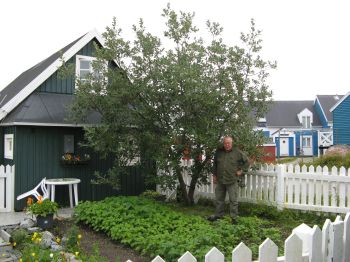 |
| Fig. 8: Felt-leaf willow (Salix alaxensis), "Kaneq" in Erik Petersen's garden, planted 1995 - the proud owner in front. Photo: Kenneth Høegh, August 2007. |
|
The willow tree in the above picture is of a clone called “Kaneq”, which is the Greenlandic name for the Icelandic clone “Hrima”. It is the most treelike clone of all the Alaskan willow-clones that has been tested in Southwest Greenland, origining from Cooper River Delta in the southernmost Alaska. “Kaneq” is extremely robust and will develop in to a polycormic tree even in the cold summer environment of Nuuk – Mainly on south-facing localities protected from the wind. An astonishing specimen is to be found near the house of “Hans Egede” in Nuuk. At Tasermiut Fjord one can find two small plantations (Fig. 9, 10) of the naturally occurring hybrid Lutz spruce from the Kenai Peninsula in Alaska. These plantation which were established in 1960 and cover an area of 5.5 hectares in total. These Lutz spruce were 2.5 m tall on average in 1987 with individuals up to 4 m tall in these stands. Today, in the summer of 2007, the trees are up to 10 m tall. Pure white spruce from Knik River near Anchorage also occurs in these stands but grows a little more slowly. Siberian larch is about 10 m tall today, but the stand is decimated by larch cancer (Potebniamyces |
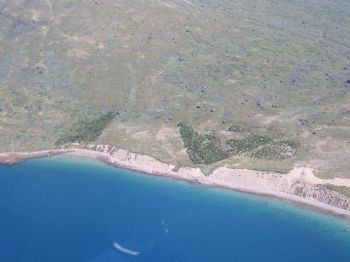 |
| Fig. 9: The two plantations at ”Kuussuaq”, The Tasermiut fiord seen from a helicopter. Photo: Rasmus Christensen, June 2004 |
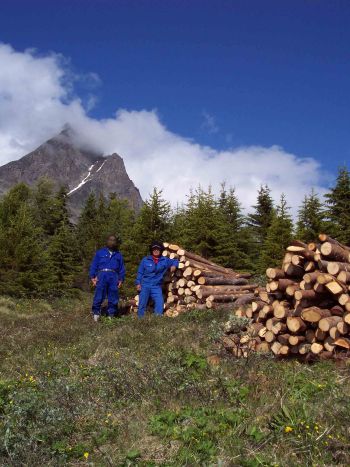 |
| Fig.10: The first timber cut in Greenland. Ole and Jonas from the municipality of Nanortalik were the first Greenlanders to become lumbers . “Kuussuaq” forest. Photo: Rasmus Christensen, July 2005 |
|
In 2005 the first timber was harvested from the plantation in the Tasermiut Fiord (Fig. 10) – first of all this was done to thin the stand and thereby increase the annual growth in the residuals but also as a project to estimate the profitability in forestry in Greenland. The logs harvested in the plantation will be used as fencepoles at Upernaviarsuk Agricultural Research Station. In the area of Narsarsuaq, not long from Rosenvinge's trees, is a small plantation, which was started in 1954. It has many tree species, for example Norway spruce (Fig. 5), Scots pine and lodgepole pine (Pinus contorta). Siberian larch from 1957 was up to 11 m tall in the summer of the year 2007 in this plantation and a forest climate has clearly developed, in spite of the small plantation size of about 1 hectare. |
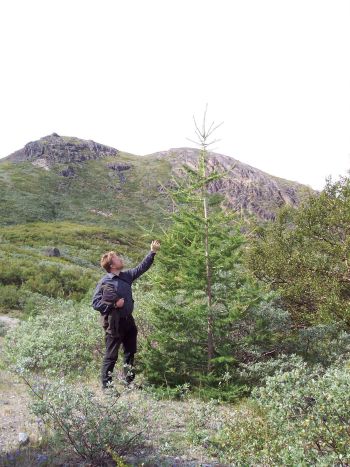 |
| Fig.11: Sibirian Larch (Larix sibirica var. sukaczewii), planted 1998. The Greenlandic Arboretum. Photo: Rasmus Christensen, July 2007 |
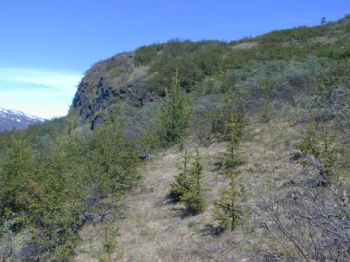 |
| Fig.12: A section of the Greenland Arboretum in Narsarsuaq with Lutz spruce (Picea x lutzii) and Siberian larch (Larix sibirica) planted respectively in 1988 and 1986. Photo Kenneth Høegh, June 2000. |
| Within this 200 hectare area one can find representatives of nearly all the subarctic and northern subalpine tree-line developing species of the northern hemisphere. Many of the species are represented with a large number of difference geographic races (provenances). The most complete collections are of white spruce, the variety of Siberian larch from the northwest par of its range (L. sibirica var. sukaczewii) (Fig. 11), subalpine fir (Abies lasiocarpa) (Fig. 6) and the inland form of lodgepole pine (P. contorta var. latifolia) (Fig. 13), |
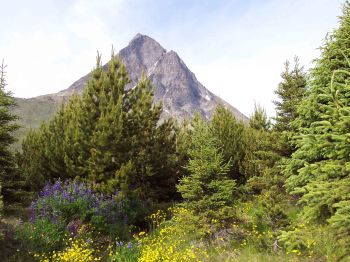 |
| Fig.13: Lodgepole pine (Pinus contorta)from Haines, Alaska, USA, planted 1984. The “Kuussuaq” forest. Photo: Rasmus Christensen, June 2004 |
| Engelmann spruce (P. engelamnnii), (Fig. 14) as well as Nordic tree-line provenances of Norway spruce and Scots pine as well as diverse broadleaved trees (Fig. 15). Rarer species such as subalpine larch (Larix lyalii), Larix lyallii x L. occidentalis, Himalaya birch (Betual utilis) and Scots Elm (Ulmus glabra) (Fig. 16) among other can also be found here. |
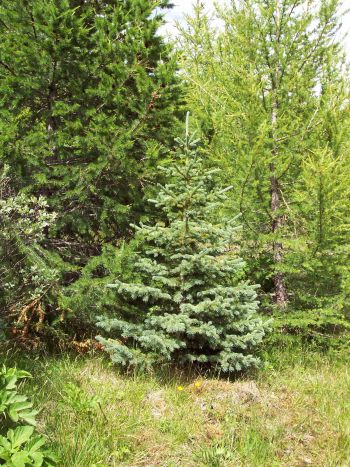 |
| Fig.14: Engelmann spruce (Picea engelmannii) in Narsarsuaq from Rio Grande del Norte, Colorado, USA, planted 1991, Photo: Rasmus Christensen, June 2007 |
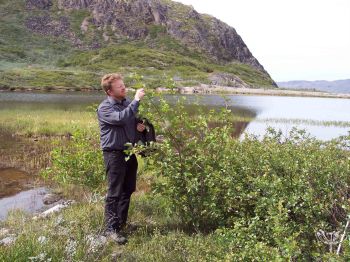 |
| Fig.15:Alder (Alnus fruticosa) planted 1997. The Greenlandic Arboretum. Photo: Rasmus Christensen, July 2007 |
|
Longer north are test plantations in Ivigtut, within Amaralikfjord, in Qorqut within Godthåbsfjord, and in Sødre Strømfjord. The annual growth-rate of the Greenlandic forests is very similar to what is observed in the rest of the subarctic areas in the Northern hemisphere. In Lapland it takes Scots pine and Norway spruce several hundred years to reach a height of about 15 m and a diameter of 40 cm. Tests with tree-growth have shown that Greenland is able to compete with this. Future larger scale plantings are planned and mainly in the region between Narsarsuaq and Tasermiut Fiord. |
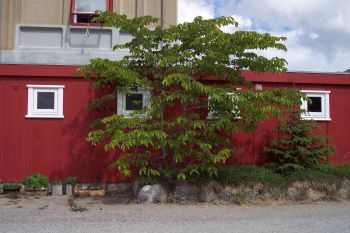 |
| Fig.16: Scots elm (Ulmus glabra) in the “Iscentralen” garden in Narsarsuaq. Photo: Rasmus Christensen, June 2007 |
|
In the northern fjord landscapes along Godhåbsfjord, the trees will most likely be, if nothing else, something exotic to experience. But the trials in Sødre Strømfjord will probably serve as a scientific experiment to test where the northern limit to the forest-line occurs. With their marginal position the Greenland forest tree stands are well suited to detect natural and man-caused climate changes and register the results in their growth rings. The arboretum and the activities in Southwest Greenland are administrated by the association “Narsarsuaq Orpiuteqarfia”. |
|
For further information on these activities in Greenland please contact “Narsarsuaq Orpiuteqarfia”:
Kenneth Høegh: kh.sava@greennet.gl |
Photos: Kenneth Høegh 2011
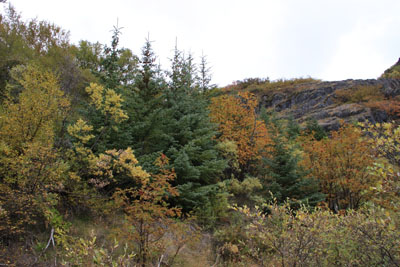 |
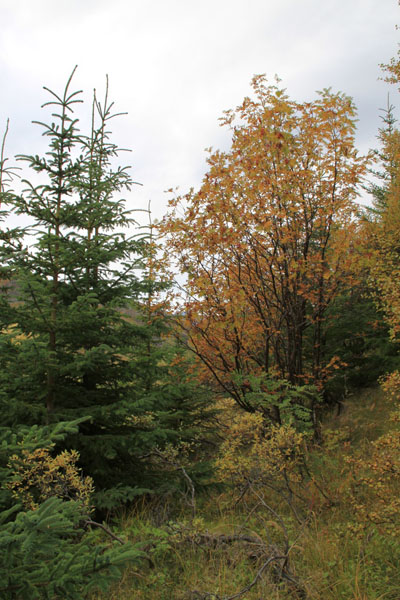 |
|
Picea x lutzii (hybrid between sitka x white spruce) collected from the Kenai Pininsula in southern Alaska. Planted in the autumn of 1988. Mountain ash (or Rowan) is the local Greenlandic mountain ash. |
|
Area A7: One of the largest Abies lasiocarpa in the Greenlandic Arboretum. Planted in 1976. |
| Area A4: Group of sibirian larch, planted 1971 |
|
Silver birch, Betula pendula, from Gällivare, Sweden, planted in 1997. Photo: Kenneth Høegh 2011 |
|
Area A4: Betula pubescens from Fokstua, Dovre fjeld, Norway (1000 mas) |
|
Picea engelmannii from Jackson, Wyoming, USA (43 02 N), planted 1976 |
|
Area A7: Pinus contorta var. latifolia, , Colorado, USA (3200 m.o.h.), planted 1976. |
|
Pseudotsuga menziesii, Upper Fraser River, BC, Canada, planted 1976. This is not a tree line species, and it can suffer from climate damage from year to year. It is the only douglas fir in Narsarsuaq. |
|
Area A8: Populus balsamifera, from Byers Lake, Parks Highway, Alaska, USA (62 45N) - planted in 1990 |
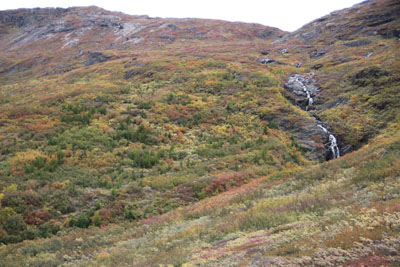 |
|
View with mixed undergrowth. |
|
Close up showing mixed undergrowth. |
The plantation Qanassiassat in south Greenland near the Greenland Arboretum in Narsarsuaq
For information on activities:
Kenneth Høegh: kh.sava@greennet.gl
Birgitte Jakobsen: vincabi@yahoo.com
Rasmus Christensen: rasmuschristensen41@hotmail.com
Erik D. Kjær: edk@ign.ku.dk
The location of the Greenlandic Arboretum
